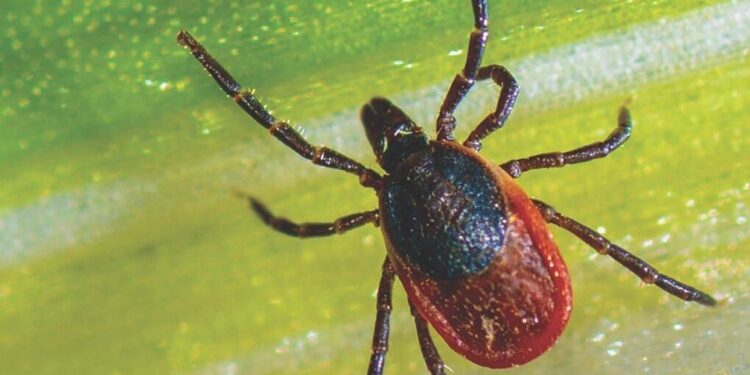Any turkey hunter that ventured out this spring can tell you that mosquitoes are not the only blood suckers out there. A little 8-legged relative of spiders, ticks, are notorious human and pet pests. And they too benefit from the wet weather. More vegetation equals more places for ticks to breed and hide.
And just like the annoying flying blood suckers, they too can spread diseases to their human meals.
Although entomologists say that the chances of conducting Lyme disease or other tick borne diseases is very, very slim, not too many folks enjoy the thought of a little passenger hitching a ride while gorging themselves on human blood.
Oklahomans are at highest risk of tickborne illness from May to August when ticks are most active. Since 2012, there have been approximately 2,000 cases of Rocky Mountain spotted fever (RMSF), ehrlichiosis, and tularemia among Oklahoma residents.
With that being said, Lyme disease is the most common vector-bord disease in the U.S. according to the CDC. Caused by the bacterium Borrelia burgdorferi and rarely, Borrelia mayonii, it is transmitted to humans through the bite of infected blacklegged ticks. Typical symptoms include fever, headache, fatigue, and a characteristic skin rash called erythema migrans. If left untreated, infection can spread to joints, the heart, and the nervous system. Lyme disease is diagnosed based on symptoms, physical findings (e.g., rash), and the possibility of exposure to infected ticks.
Each year, 30,000 cases of Lyme disease are reported by the CDC, and there are probably thousands more that go undiagnosed, or reported. Fortunately Lyme disease is rarely fatal.
And now a new tick-borne disease is spreading across the U.S. Heartland virus is spread by the Lone Star tick. This infection can be asymptomatic or cause mild to severe illnesses that can be fatal. The CDC has recorded more than 60 cases in 2023, including Oklahoma.
Symptoms of Heartland virus include fever, fatigue (feeling tired), decreased appetite, headache, nausea, diarrhea, and muscle or joint pain.
If you are headed to the field, pond or lake, take these tips from the American Camping Association to help make your trip to the woods free from pesky ticks:
• Wear long sleeves buttoned at the wrist and long pants tucked into socks or boots. Take a hat to protect your head.
• Walk in the center of trails to avoid brushing up against dense vegetation where ticks hide. Avoid sitting directly on the ground, use a seat or cushion.
• Do a tick check every few hours or more often if in heavily infested areas. Visually check clothing and exposed skin. At the end of the day, do a final, full-body tick check.
• Use an insect repellant containing DEET. Lightly spray clothing, especially children’s, and avoid direct contact with skin.
• If you do find a tick, prompt removal of an attached tick will reduce the chance of Lyme disease infection. Use thin-tipped tweezers or forceps to grasp the tick as close to the skin surface as possible. Pull the tick straight upward with steady even pressure. This should remove the tick with the mouth parts intact.
• If the mouth parts break off, it will not affect the chance of getting Lyme disease. Disinfect the area; a topical antibiotic may also be applied. Other methods of tick removal (e.g. petroleum jelly to suffocate the tick) are not effective. Use of heat from matches to make the tick back out or gasoline or other chemicals are unacceptable.
• Note the site and date of the bite. Watch for signs and symptoms of Lyme disease, which include a rash around the bite area and flu-like symptoms. If such symptoms occur, see a doctor as soon as possible
Want to reach a local audience and grow your business?
Our website is the perfect platform to connect with engaged readers in your local area.
Whether you're looking for banner ads, sponsored content, or custom promotions, we can tailor a package to meet your needs.
Contact us today to learn more about advertising opportunities!
CONTACT US NOW







